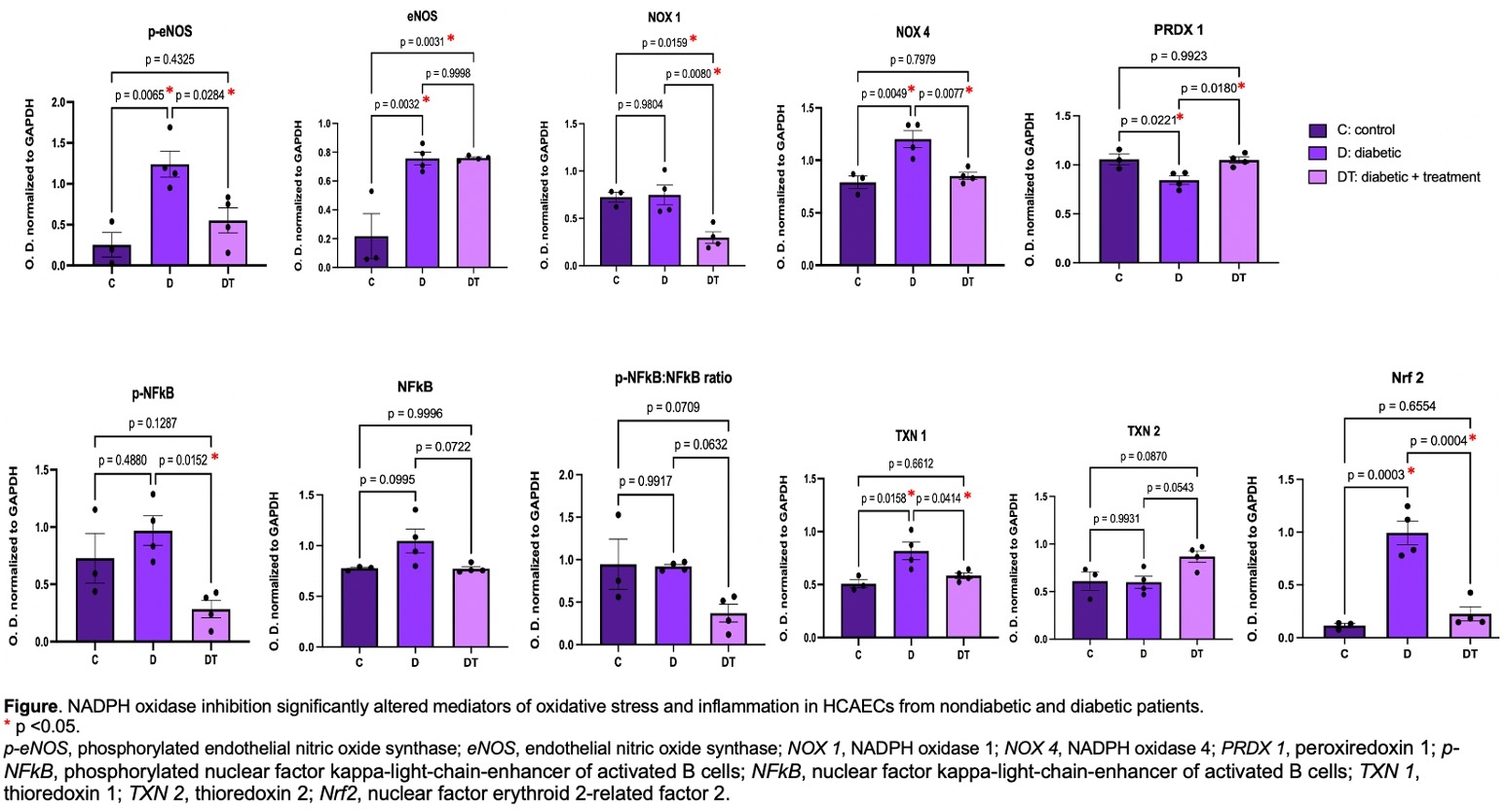Final ID: Tu028
NADPH Oxidase Inhibition Antagonizes Endothelial Pro-inflammatory and Pro-oxidant Signaling Resulting in Enhanced Coronary Vasorelaxation in Diabetic Models
Abstract Body: Introduction: NADPH oxidase (NOX) overactivation and reactive oxygen species amplification may underlie worse cardiac outcomes in patients with diabetes. Our group has shown impaired endothelium-dependent coronary vasodilation in diabetes, with restored endothelial function following NOX inhibition. Persistently high levels of oxidative stress may be driving this impaired coronary microvascular reactivity by altering small-conductance potassium channel activity. We hypothesized that NADPH oxidase inhibition would be vasoprotective through reductions in pro-oxidant and pro-inflammatory signaling.
Methods: Human coronary arterial endothelial cells (HCAECs) were obtained from diabetic (D) and nondiabetic (C) patients (N = 4 per group). HCAECs were cultured in normo- or hyperglycemic conditions, with one hyperglycemic group receiving NADPH oxidase inhibitor apocynin (DT). Molecular signaling was assessed using immunoblotting.
Results: Diabetes resulted in significantly increased pro-oxidant markers, including NOX 4 (p = 0.005), phosphorylated endothelial nitric oxide synthase (p-eNOS) (p = 0.007), and eNOS (p = 0.003). Pro-inflammatory Nrf2 was also increased (p = 0.0003), with a trend toward increased NFkB (p = 0.09) in D compared to C. Antioxidant peroxiredoxin (PRDX) 1 was significantly reduced in D compared to C (p = 0.02). NOX inhibition rescued these effects, with reversed trends in NOX 4 (p = 0.008), p-eNOS (p = 0.03), and PRDX 1 (p = 0.02) following apocynin treatment. NOX inhibition resulted in de novo decrease in NOX 1 in DT when compared to D (p = 0.008) and C (p = 0.02), and decrease in phosphorylated NFkB (p-NFkB) when compared to D (p = 0.02). There was a trend toward decreased total NFkB (p = 0.07) and p-NFkB:NFkB ratio (p = 0.06) and increased antioxidant thioredoxin (TXN) 2 (p = 0.05) in diabetic cells following treatment. Antioxidant superoxide dismutase (SOD) 2 (p = 0.01) and TXN 1 (p = 0.02) were increased in D when compared to C, while apocynin treatment reversed these changes (SOD 2, p = 0.0006; TXN 1, p = 0.04). There were no significant differences in NOX 2, SOD 1, catalase, PRDX 2, or PRDX 3 between the groups.
Conclusions: Apocynin overall suppressed pro-oxidant and pro-inflammatory signaling in human diabetic coronary endothelial cells, resulting in improved coronary endothelium-dependent vasorelaxation. Cardioprotective strategies that incorporate NADPH oxidase inhibition in the setting of diabetes warrant further investigation.
Methods: Human coronary arterial endothelial cells (HCAECs) were obtained from diabetic (D) and nondiabetic (C) patients (N = 4 per group). HCAECs were cultured in normo- or hyperglycemic conditions, with one hyperglycemic group receiving NADPH oxidase inhibitor apocynin (DT). Molecular signaling was assessed using immunoblotting.
Results: Diabetes resulted in significantly increased pro-oxidant markers, including NOX 4 (p = 0.005), phosphorylated endothelial nitric oxide synthase (p-eNOS) (p = 0.007), and eNOS (p = 0.003). Pro-inflammatory Nrf2 was also increased (p = 0.0003), with a trend toward increased NFkB (p = 0.09) in D compared to C. Antioxidant peroxiredoxin (PRDX) 1 was significantly reduced in D compared to C (p = 0.02). NOX inhibition rescued these effects, with reversed trends in NOX 4 (p = 0.008), p-eNOS (p = 0.03), and PRDX 1 (p = 0.02) following apocynin treatment. NOX inhibition resulted in de novo decrease in NOX 1 in DT when compared to D (p = 0.008) and C (p = 0.02), and decrease in phosphorylated NFkB (p-NFkB) when compared to D (p = 0.02). There was a trend toward decreased total NFkB (p = 0.07) and p-NFkB:NFkB ratio (p = 0.06) and increased antioxidant thioredoxin (TXN) 2 (p = 0.05) in diabetic cells following treatment. Antioxidant superoxide dismutase (SOD) 2 (p = 0.01) and TXN 1 (p = 0.02) were increased in D when compared to C, while apocynin treatment reversed these changes (SOD 2, p = 0.0006; TXN 1, p = 0.04). There were no significant differences in NOX 2, SOD 1, catalase, PRDX 2, or PRDX 3 between the groups.
Conclusions: Apocynin overall suppressed pro-oxidant and pro-inflammatory signaling in human diabetic coronary endothelial cells, resulting in improved coronary endothelium-dependent vasorelaxation. Cardioprotective strategies that incorporate NADPH oxidase inhibition in the setting of diabetes warrant further investigation.
More abstracts on this topic:
Aortic Stenosis is Promoted by Ferroptosis via 5-Lipoxygenase
Qin Zihan, Haftbaradaran Esfahani Payam, Pawelzik Sven-christian, Bosman Matthias, Bergstrom Goran, Guns Pieter-jan, Franco-cereceda Anders, Back Magnus
ROS-Detoxifying Cerium Oxide Nanoparticles Attenuate the Pro-Arrhythmic Effect of Diesel Exhaust Particles in Isolated Rat HeartsGanse Gino Freddy Sena, Rodriguez-sinovas Antonio, Rodriguez Cristina, Ernst Lena, Ruiz-meana Marisol, Inserte Javier, Martinez-gonzalez Jose, Benito Begona, Puntes Victor, Ferreira-gonzalez Ignacio

